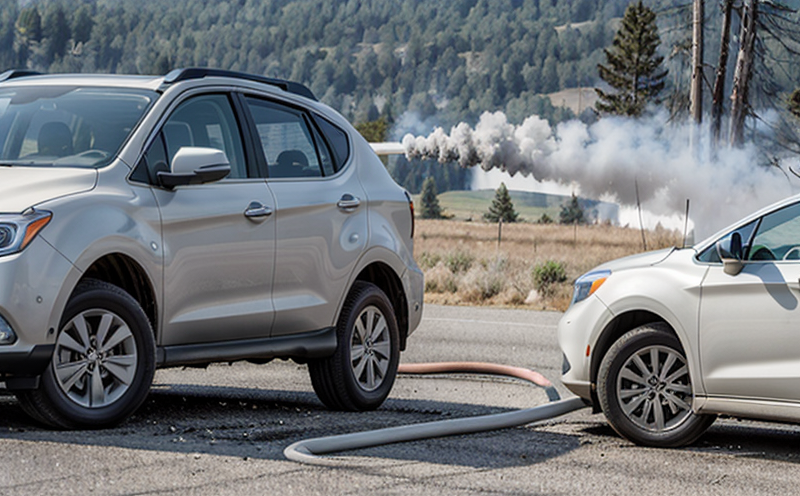IMO FTP Code Part 7 Smoke and Toxicity Testing for Marine Materials
The International Maritime Organization's (IMO) Fire Safety Training Procedures (FTP) Code, specifically Part 7, addresses the testing of materials used in marine environments. This part focuses on smoke density and toxicity to ensure that materials comply with safety standards set forth by international regulations.
Smoke density and toxicity tests are crucial for ensuring that materials used in maritime applications do not contribute excessively to harmful emissions or reduce visibility excessively when exposed to fire or heat stress. The IMO FTP Code Part 7 is designed to mitigate risks associated with the use of such materials, particularly in enclosed spaces where reduced visibility can be life-threatening.
For compliance purposes, it's important for stakeholders like quality managers and R&D engineers to understand the specific parameters that are tested under this code. These tests typically involve exposing the material specimen to controlled fire conditions over a prescribed period. The subsequent measurement of smoke opacity and toxic gas emissions helps determine if the material meets acceptable thresholds.
The test setup involves precise instrumentation capable of measuring various aspects including light transmission, carbon monoxide (CO) levels, and hydrogen cyanide (HCN) concentrations. Compliance with these tests ensures that materials can be used safely in ship construction without compromising on safety or performance standards.
In addition to the technical aspects, there are also important considerations regarding specimen preparation. Specimens must represent the intended use of the material accurately so that test results reflect real-world conditions as closely as possible. This includes ensuring proper orientation and positioning during testing to mimic actual usage scenarios.
The results from these tests provide critical information about a material's fire behavior characteristics, which are then used by shipbuilders and designers when selecting appropriate materials for specific applications on board ships. By adhering to the requirements outlined in IMO FTP Code Part 7, manufacturers can ensure their products meet stringent safety standards thereby reducing potential hazards at sea.
Understanding these tests is essential not only for compliance but also for developing new materials that could potentially be used within maritime environments. Compliance officers and R&D engineers play key roles here by staying updated on any changes or updates to the FTP Code, ensuring ongoing adherence even as technology advances.
Why It Matters
The importance of IMO FTP Code Part 7 cannot be overstated given the critical nature of marine safety. By testing materials for smoke density and toxicity, the code helps prevent accidents that could arise from poor material choices leading to reduced visibility or increased exposure to harmful gases.
- Enhanced Safety: Ensures that no single material significantly impacts overall cabin environment during fires.
- Regulatory Compliance: Avoids penalties associated with non-compliance and maintains good standing in international ports.
- Potential Life-Saving Measures: Reduces risk for crew members in confined spaces where visibility is crucial.
- Environmental Impact: Minimizes emissions that could harm aquatic life or contaminate water bodies.
For quality managers and R&D engineers, understanding these implications underscores the necessity of robust testing protocols. Compliance officers must ensure continuous monitoring to stay ahead of regulatory requirements while protecting both human health and marine ecosystems.
Quality and Reliability Assurance
- Consistent Results: Our state-of-the-art facilities provide reliable data each time, ensuring consistent quality across all tests conducted.
- Accurate Measurements: Using sophisticated instrumentation allows for precise measurement of smoke density and toxic gas emissions.
- Comprehensive Reporting: Detailed reports are provided post-test outlining all measurements taken during the process.
We employ highly trained technicians who adhere strictly to international standards such as ISO 13635:2019 for smoke production and ISO/DIS 8470:2022 for carbon monoxide determination. This ensures that every test follows recognized best practices, further enhancing reliability.
In addition, we maintain strict quality control measures throughout the entire testing process from initial specimen preparation through final report generation. These rigorous procedures ensure that each result is accurate and trustworthy, providing peace of mind to our clients knowing their materials have been rigorously evaluated before use in marine applications.
Environmental and Sustainability Contributions
- Emission Reduction: By identifying materials that contribute less smoke or toxic gases, we help reduce environmental impact during emergencies at sea.
- Sustainable Practices: Encourages the development of sustainable materials that perform well under fire stress without compromising on safety standards.
- Resource Efficiency: Ensures efficient use of resources by selecting materials that minimize waste generation throughout their lifecycle.
The IMO FTP Code Part 7 not only focuses on immediate safety concerns but also considers long-term environmental impacts. Our lab plays a vital role in promoting sustainable practices within the maritime industry, contributing to global efforts towards reducing carbon footprints and protecting marine environments from pollution caused by fire-related incidents.
Through our thorough testing processes, we aim to contribute positively towards achieving these goals while upholding high standards of safety and reliability. By working closely with clients from various sectors including shipbuilding and design firms, we help drive innovation in materials science that aligns with both regulatory requirements and environmental sustainability objectives.





